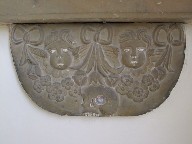| |
|
.jpg) |
|
Stansfield
was a place I sometimes recalled with
affection - the church, for it was one of
the first I'd visited when I started
doing the Suffolk Churches Site back in
the late 1990s. Like its neighbour Rede,
I remembered it as an utterly ordinary
little place, but open and welcoming,
full of a sense of its own past, the
recent and more distant. But it was easy
for me to find other places to go, and I
did not come back to Stansfield for
nearly 15 years. In the gently rolling hills
of south west Suffolk, tiny villages
sleep the sleep of the quietly forgotten.
How many people have even heard of
Stansfield? Here, in this intensely
agricultural corner, where the fold of a
ploughed field can swallow a church
tower, one might pass close by without
ever knowing. So it was with a slight
sense of guilt that I rolled up on a day
of sub-zero temperatures in February
2013, flakes of snow combatting the north
wind, only to find the church locked.
|
I needn't have
worried, however. For ordinarily this church is
open every day, and coming back a few weeks later
on a sunny April Saturday I found the big south
door wedged open with a kneeler, to let in the
air and the sunshine and me.
Here,
in the shadow of the glories of its famous other
neighbour Denston, All Saints is a
surprisingly large church. As you approach, the
most striking survivals are a fine pair of
decorated niches either side of the east window,
as at Cotton, and a superb roodloft stair turret, rising above the
roofline and surmounted by battlements, as at Clare. You can imagine a late
medieval mason seeing the grand ones there and
thinking hmm, I could do something like that.
These survivals are signs that the Victorians
were gentle with All Saints.
The
light Victorian restorations in this part of East
Anglia are a reminder that this was a poor place
then, which also explains Denston's survival. This is a church
of the common people, where the plowman and the
sheepboy came to worship. The poor font where
they were baptised has been terribly chopped
about, and it is hard to see exactly which
century produced it - Mortlock thought the late
13th. It now stands rather awkwardly on High
Victorian marble legs.
The
roof is late medieval, and is said to bear a
carving on one spandrel of a scene from the
legend of St George, although I am afraid that I
could not make it out with my poor eyesight. An
image niche containing a modern madonna marks the
site of a chantry altar for the guild of St Mary. The piscina that served the altar can be seen
beside it, beneath the window.
Another madonna, in the form
of a relief, leans in a window splay
between the two war memorials. These are
both to the First World War, which may
seem surprising; but one remembers the
Stansfield Congregational Sunday School
boys who went off to die, and was brought
here from elsewhere. The other is the
parish memorial.
Arthur Mee records
the memory of Samuel Ogden, a Rector here
in the 18th Century. He preached brilliant
sermons in a growling voice, peppered
with epigrams which were not understood
by anyone in his congregation. It
was not unknown for him to preach in
Latin, or even Arabic. Mee claims that he
was a popular man, and was admired by Dr
Johnson. One wonders what the plowman and
the sheepboy made of him.
|
|
 |
|
|
|

